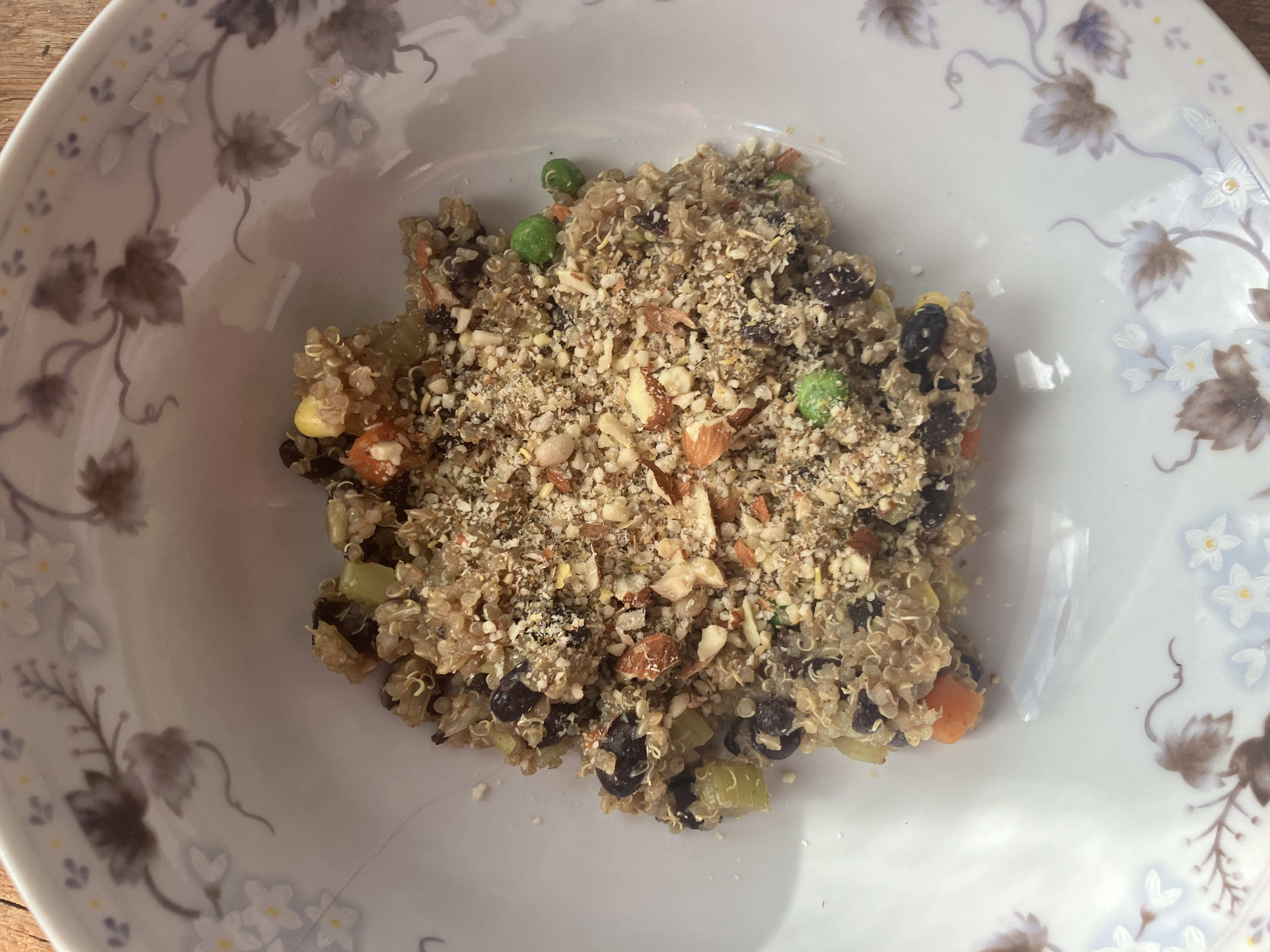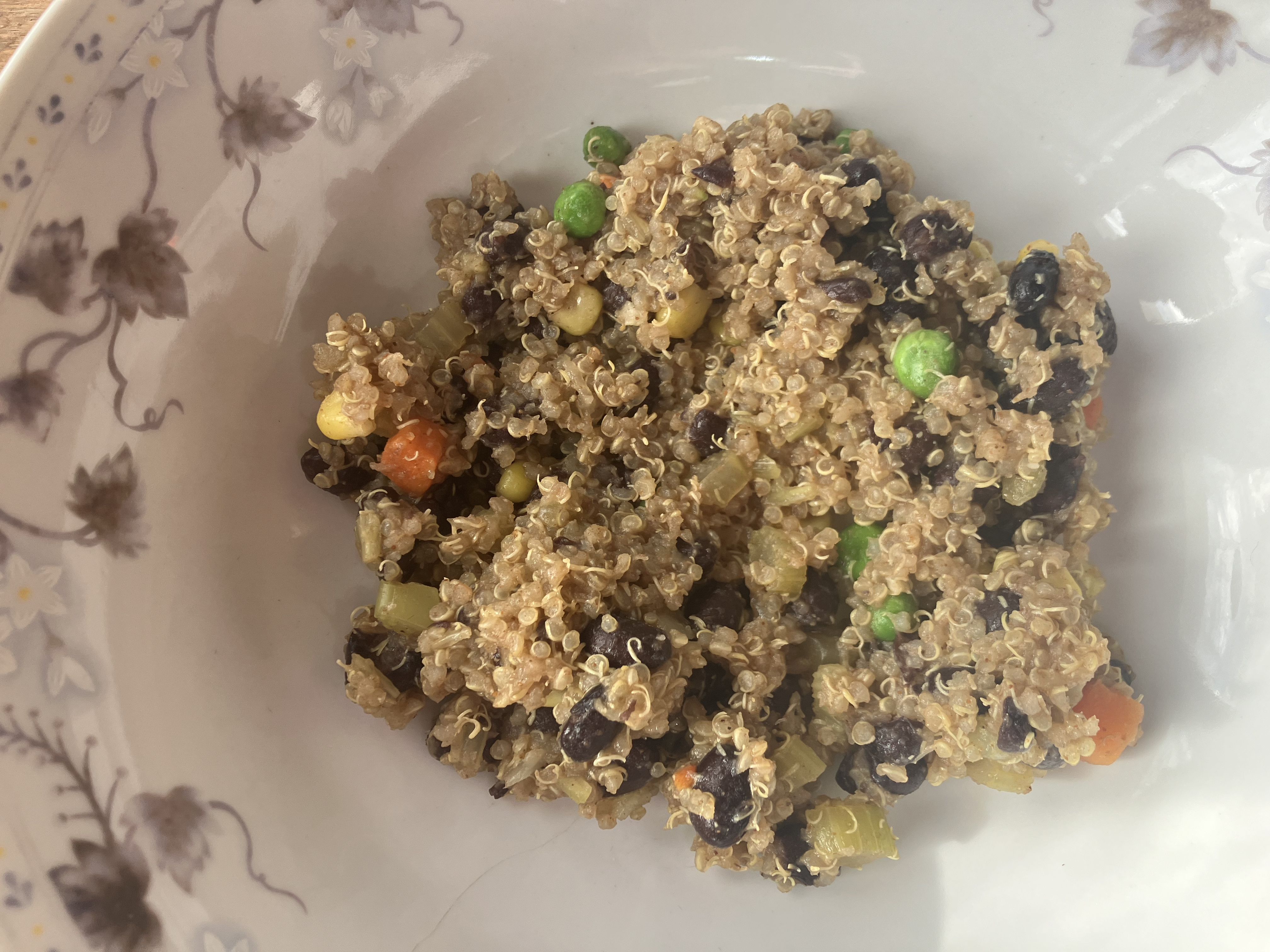|

Quinoa and Black Beans
Sophia W. (original recipe)
My notes say, "I stopped here to watch hockey" which I'm sure endears myself to your proud
state.
This recipe looks a little strange on paper, but these kids know a secret which is that
quinoa makes any recipe great. Yes, it's expensive, which is why some kids have the clever
idea of cutting it with a cheaper grain. It's super nutritious, though, as well as
tasty, so at least you are getting value.
I guess I may as well add that I am currently unswayed by the argument that we shouldn't eat
quinoa because it makes it too expensive for Peruvians to afford it. If Peru wanted, it could
make sure that quinoa is affordable to its people whatever the international price but they
make more by selling it to wealthy Americans and then choose to spend the money on other things
which is their choice. Maybe the Peruvian government fails to represent the interests of its
quinoa-consuming citizens and this is a real concern but as a practical solution I would
pressure the Peruvian government to take action, they can afford to by selling some to us
at a ridiculous price but if everyone stopped buying it then that would take this option off
the table, as it were. I'm not an expert on this so feel free to contact me with your take on
the issue. In the meanwhile, if I omitted quinoa from this project I would have nothing left
to cook, so I will make a commitment to further educate myself as I use up what I've already
bought. I will be sure to appreciate it.
This recipe called for cheese optionally, and I knew this was the perfect excuse to show
off my classic parm substitute. My town used to have two 24-hour diners and now it has none.
When my life fell apart and I was all on my own, I used to eat at a diner frequently. I would
order spaghetti marinara and top it off with my parm shake from a cool shaker that I bought at
a local restaurant supply store. I almost bought another for this project because it was pretty
cool, everyone at the diner thought it was pretty cool, but in truth, a regular jar is much
more practical.
Pine nuts, like quinoa, are expensive but they pack a lot of punch. Minnesota may be
interested to note it is one of few, if not the only, commercial crop from a coniferous
tree. Your state tree is the red pine!
Diners are kind of an eastern thing so I don't know if you have them in Minnesota, but
I thought this anecdote would give me the opportunity to share my wealth deserts program.
This resulted from pondering the issue of urban food deserts and realizing it was basically
the same problem as the provisioning of services in rural areas. What they have in common is
the characteristic of low wealth density. A Whole Foods is never going to open there because
there is simply not enough wealth to support one.
I've been to rich rural communities and often these can support services, but for the
urban and rural poor and the rural middle class, what's needed is a program that can help
subsidize service providers in these areas. Food deserts may have a population to serve,
but need help to do so profitably. Meanwhile, much of small-town America is eroding, and
my program would subsidize livelihoods in these communities. Giant corporations get tax
breaks when they create jobs, so why not small entrepreneurs who see a community need and
seek to meet it?
This idea is pretty nascent, but I think the economic issue it seeks to address is pressing.
My instinct is to subsidize labor costs (encourage hiring) by forgiving some or all payroll
costs for service providers (e.g., food, healthcare) in areas of low wealth density. Of
course, we still need to pay for Social Security and Medicare, but payroll is kind of a
bad way of doing that. I think my approach is a good framework
for thinking about it because a good policy has "knobs" that we can use to adjust it through
adaptive management, or else to phase it in slowly, and this policy approach has several
knobs, e.g., how to measure wealth density, the levels of payroll forgiveness, how the two relate.
One of my favorite restaurants in town was shut down for failing to pay payroll tax. Maybe
it was an act of protest.
Ingredients
- 3/4 cube Vegetable bouillon
- 1 cu. frozen Mixed vegetables, thawed
- 1 15-oz. can Black beans, rinsed and drained
Parm Shake
Preparation
Heat oil in a medium saucepan. Over medium heat, saute the celery and garlic
for about 3 minutes. Add the quinoa, water, bouillon, cumin, and chili powder.
Bring to a boil, then lower the heat, cover, and simmer 20 minutes.
To make the parm shake, simply combine ingredients in a jar and shake to mix.
Add the mixed vegetables and black beans to the saucepan and heat.
Season with pepper and serve along side jar of parm shake.
Discussion

This is what it looks like before parm shake.
I wasn't sure whether I'd been through Minnesota or not but turns out, I have! I know because I
stayed the night near the Mayo Clinic, which is Rochester, MN. I knew Rochester, MN existed as a kid
because it would pop up when I searched for rock concerts to go to in Rochester, NY. I saw some great
bands there, oftentimes right before they went through kind of a crappy period -perhaps they
crossed-over? Taytay style- (so I saw them at just
the right moment). I'm sure your Rochester gets mixed up with our Rochester all the time.
|
|